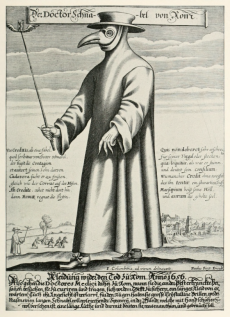Wearing the plague on the face – masks as a sign of an invisible event
By Historian Katharina Wolff

When we think of masks and plagues, we soon think of the well-known mask of the Plague Doctor. The mask can be seen in early-modern depictions, the figure in a long black coat, perhaps with a staff, gloved hands, and a scholarly hat that helps us recognize the doctor. He wears on his face the mask that is supposed to protect him from the contagious fumes of the sick. The Greek term “miasma” means something like “evil fumes” or “bad air”. The idea of such wandering masses of air that can make people sick goes back to the ancient Hippocratic writings. Miasmatic theory, which is behind the protective clothing worn by the Doctor, had been one of the oldest and most widespread theories about the nature of the plague in the Europe of the great epidemics since about 1348. Medieval tracts on the plague advised their readers to surround themselves with fragrant fabrics to avoid the pernicious breath exhaled by other people. Those living with the plague were recommended to air their rooms properly, to sprinkle their houses with vinegar and rosewater, to burn fragrant woods, but also to scatter and carry fragrant parts of plants, ambergris, or similar things. But they did not wear a mask, although they believed themselves to be in danger even when they were out and about. Not least, people were advised to avoid crowds. People still took their individual protection against the plague with them: those in the know and who had the money carried with them the recommended fragrances in small bundles. The so-called musk apple was held in front of the mouth and nose so that the person could inhale its fragrance instead of polluted air. Such a bundle had already been recommended in the widely known Parisian report on the plague from 1348. Written at the behest of the French king, the report called on the medical staff of the University of Paris to provide policy advice, and established the genre for such reports.

The portrait of the Constance patrician Heinrich Blarer from 1460 shows just how sophisticated the design of this individual protection against the plague could be. Wearing the protection, which is probably made of wrought silver and is adorned with a decorated arm chain, he proudly holds in front of him what was protecting him during those difficult times. But the habit of wearing the fragrances directly on the face did not develop. Nevertheless, the beak-like mask worn by the early-modern Plague Doctor is said to have been filled with such fragrances. The fact that he did not exist at all, or hardly anywhere, has been demonstrated in a recent essay published in 2019 by the doctor and medical historian Marion Ruisinger. But the frightening and disconcerting figure has remained very present throughout the centuries, and stands to this day for the horror of the plague, or even for the plague itself. And it is not only from the point of view of those living in the 20th and 21st centuries that the figure of the Doctor has come to symbolize the plague: one of the most well-known depictions shows some people in the background fleeing when they see the Doctor. The Doctor in his gruesome outfit stands for the plague itself. Barely recognizable as a human being, this figure, when approaching the patient, may have conveyed a feeling less of relief and the certainty of imminent help, and more of fear and forsakenness. Thus, the figure and especially the uncanny mask of the supposed Plague Doctor became a symbol of the plague itself, a phenomenon from which people fled.
But everything is different today. Isn’t it? After all, the masks of the modern age are signs of science and technocracy; they are based on empirically proven facts. On the one hand, where the medicine of the Western world is not or not yet widely used, we can observe scenes of rejection even today. For example, during the great Ebola epidemic between 2014 and 2016, riots broke out against aid workers who came to remote settlements in West Africa in their full protective clothing. From the point of view of the locals, these aid workers had brought the epidemic with them in the first place. As changing indicators of an invisible event, a diffuse threat, these masked figures made the epidemic visible and real. The horror was further fuelled by the observation that those who were brought into a treatment centre by those wearing masks often did not leave it alive. But there is resistance to the wearing of everyday masks even in Germany, and in those populations whose relatives have been accustomed since birth to modern, Western medicine and its methods of argumentation, who have heard of pathogens and infection, of disinfection and vaccines. There are certainly many reasons for such behaviour. Coping with complexity may be one: being able to assess the situation, and the sense or nonsense of a prescribed measure, requires a certain level of knowledge, which in turn requires a lot of reading and patience. Denying the existence of the pandemic and refusing to wear a mask is a shortcut out of this situation.
For many people, the mask is a manifestation and admission that an epidemic or pandemic exists. People wear the sign of its existence on their face, and the act of putting the mask on is a confession and declaration of participation in this frightening (un)certainty. The flag of the epidemic is hoisted on their faces; and, from that moment on, there is no way to escape the resulting instructions of medical-political expertise, which constantly changes, is uncomfortable, and makes everyday life difficult. The mask as part of protective clothing brings a disease into the visible spectrum, makes it frighteningly real; and the face disappears behind the layers, the individual disappears for a collective, larger goal – namely, of fighting the epidemic.

